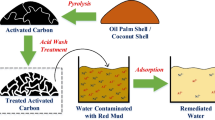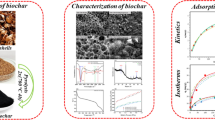Abstract
In this study, we investigated the removal of metolachlor (MET) by biochar (BC) prepared from walnut shells (W-BC) compared with BCs made from cow dung (D-BC) and corn cobs (C-BC) by characterizing the adsorption kinetics, pH, adsorbent dose, and ionic strength, and using isotherm models. Weight analysis was also conducted to understand the adsorption capacity and adsorption mechanisms. The results showed that the MET removal rates were 87.89% (W-BC), 52.91% (D-BC), and 10.91% (C-BC), respectively. According to the results fitted to the Langmuir isotherm model, the saturated adsorption capacities for MET were 96.15 mg g−1, 37.88 mg g−1, and 11.98 mg g−1 with W-BC, D-BC, and C-BC, respectively. The results demonstrated that W-BC was particularly effective at MET removal. Analyses based on the weights of different factors showed that the correlation coefficient was highest for the BC type with 46.11% in the MET adsorption process, followed by the initial concentration of MET (19.29%). The adsorption of MET by BCs was probably influenced mostly by electron donor–acceptor interactions and pore filling. These results may facilitate further studies of the adsorption mechanism and optimization of the process.






Similar content being viewed by others
Data availability
All data, materials, or models generated or used during the study appear in the submitted manuscript.
References
Barra C, Giuliano G, Grenni P, Guzzella L, Pozzoni F, Bottoni P, Fava L, Crobe A (2005) Degradation and leaching of the herbicides metolachlor and diuron: a case study in an area of Northern Italy. Environ Pollut 103(3):525–534
Chen BL, Chen ZM (2009) Sorption of naphthalene and 1-naphthol by biochars of orange peels with different pyrolytic temperatures. Chemosphere 76(1):127–133
Chen Y, Zhang X, Chen W, Yang H, Chen H (2017) The structure evolution of biochar from biomass pyrolysis and its correlation with gas pollutant adsorption performance. Bioresour Technol 246:101–109
Cwielag-Piasecka I, Medynska-Juraszek A, Jerzykiewicz M, Debicka M, Bekier J, Jamroz E, Kawalko D (2018) Humic acid and biochar as specific sorbents of pesticides. J Soils Sediments 18(8):2692–2702
Dai Y, Zhang K, Meng X, Li J, Guan X, Sun Q, Sun Y, Wang Y, Wang W (2019a) New use for spent coffee ground as an adsorbent for tetracycline removal in water. Chemosphere 215:163–172
Dai Y, Zhang N, Xing C, Cui Q, Sun Q (2019b) The adsorption, regeneration and engineering applications of biochar for removal organic pollutants: a review. Chemosphere 223:12–27
Dai Y, Li J, Shan D (2020) Adsorption of tetracycline in aqueous solution by biochar derived from waste Auricularia auricula dregs. Chemosphere 238:124432
Deng X, Zheng W, Zhan Q, Deng Y, Zhou Y, Bai L (2020) New lead discovery of herbicide safener for metolachlor based on a scaffold-hopping strategy. Molecules 25(21):4986
Dong C (2018) Effects of biochar and its aging on the adsorption mechanism of cadmium and ammonia nitrogen, Ph.D. Dissertation, Wuhan University
Ge C, Guo X, Li J, Lv J, Liu S, Xu H (2016) Adsorption and slow-release effect of rice straw biochar on metolachlor. J Ecology Rural Environ 132(01):168–172
Guelfi D, Gozzi F, Machulek A, Sires I, Brillas E, de Oliveira S (2018) Degradation of herbicide S-metolachlor by electrochemical AOPs using a boron-doped diamond anode. Catal Today 313:182–188
He X, Jiang J, Hong Z, Pan X, Dong Y, Xu R (2020) Effect of aluminum modification of rice straw-based biochar on arsenate adsorption. J Soils Sediments 20(8):3073–3082
Hu J (2009) Study on the immunotoxic effect of metolachlor in mice. J Harbin Med Univ 1:57–59
Josef V, Alzbeta S, Eliska Z, Jan K, Milos B, Antonin K (2018) Chronic toxicity of metolachlor oa on growth, ontogenetic development, antioxidant biomarkers and histopathology of early life stages of marbled crayfish. Sci Total Environ 43:1456–1463
Kan T, Strezov V, Evans TJ (2016) Lignocellulosic biomass pyrolysis: a review of product properties and effects of pyrolysis parameters. Renew Sust Energ Rev 57:1126–1140
Kumar Y, Singh N, Singh S (2017) Removal of herbicides mixture of atrazine, metribuzin, metolachlor and alachlor from water using granular carbon. Indian J Chem Technol 24(4):400–404
Li C, Zhang L, Gao Y, Li A (2018) Facile synthesis of nano ZnO/ZnS modified biochar by directly pyrolyzing. Waste Manag 79:625–637
Liu C, Chen L, Ding D, Cai T (2019) From rice straw to magnetically recoverable nitrogen doped biochar: efficient activation of peroxymonosulfate for the degradation of metolachlor. Appl Catal B-environ 254:312–320
Mandal A, Singh N, Purakayastha T (2017) Characterization of pesticide sorption behaviour of slow pyrolysis biochars as low cost adsorbent for atrazine and imidacloprid removal. Sci Total Environ 577:376–385
Nguyen T, Xu C, Tahmasbian I, Che R, Xu Z, Zhou X, Wallace H, Bai S (2017) Effects of biochar on soil available inorganic nitrogen: a review and meta-analysis. Geoderma 288:79–96
Nie T (2019) Effect of aging on the adsorption of tetracycline and copper on biochar and mechanism research. Ph.M. Dissertation, Zhejiang University
Orge C, Pereira F, Faria J (2017) Photocatalyic-assisted ozone degradation of metolachlor aqueous solution. Chem Eng J 318:247–253
Otero R, Fernandez J, Ulibarri M, Celie R, Bruna F (2016a) Adsorption of non-ionic pesticide S-Metolachlor on layered double hydroxides intercalated with dodecylsulfate and tetradecanedioate anions. Appl Clay Sci 65:72–79
Otero R, Lopez M, Esquivel D, Fernandez J (2016b) Romero-Salguero, F., Removal of S-metolachlor herbicide from aqueous solutions by meso and microporous organosilica materials. Microporous Mesoporous Mater 278:35–43
Ozcimen D, Ersoy-Mericboyu A (2010) Characterization of biochar and bio-oil samples obtained from carbonization of various biomass materials. Renew Energy 35(06):1319–1324
Qu JH, Akindolie MS, Feng Y, Jiang Z, Zhang GS, Jiang Q, Deng FX, Cao B, Zhang Y (2020) One-pot hydrothermal synthesis of NaLa(CO3)(2) decorated magnetic biochar for efficient phosphate removal from water: Kinetics, isotherms, thermodynamics, mechanisms and reusability exploration. Chem Eng J 394:124915
Rode J (2019) Statistical software output in the classroom: a comparison of R and SPSS. Teach Psychol 46(4):319–327
Rose C, Coupe R, Capel P, Webb R (2018) Holistic assessment of occurrence and fate of metolachlor within environmental compartments of agricultural watersheds. Sci Total Environ 612(15):708–719
Rytow G, Gonen Y, Afuta S (2008) Preparation of berberine-montmorillonite-metolachlor formulations from hydrophobic/hydrophilic mixtures. Appl Clay Sci 41:47–60
Shattar S, Zalzaria N, Foo K (2019) Preparation of a montmorillonite-derived adsorbent for the practical treatment of ionic and nonionic pesticides. J Mater Res Technol 8(5):4713–4724
Sigmund G, Castan S, Wabnitz C, Bakkour R, Huffffer T, Hofmann T, Elsner M (2019) NO2 and natural organic matter affect both soot aggregation behavior and sorption of S-metolachlor. Environ. Sci.: Proc. Imp. c9em00354a
Stapf D (2017) Efficiency of biomass energy: an exergy approach to biofuels, power and biorefineries. Chem Ing Techol 89(6):831–838
Sun Y, Zhao L, Li X, Hao Y, Xu H, Weng L, Li Y (2019) Stimulation of earthworms (Eisenia fetida) on soil microbial communities to promote metolachlor degradation. Environ Pollut 248:219–228
Szabo N (2015) Hydraulic conductivity explored by factor analysis of borehole geophysical data. Hydrogeol J 23(5):869–882
Tijani H, Yuzir A, Abdullah N, Sallis P (2017) Impact of (RS)-MCPP herbicide and sulphate on the treatment performance, kinetics and microbial diversity of anaerobic membrane bioreactor. J Environ Eng 5(6):5389–5395
Treviño-Cordero H, Juárez-Aguilar L, Mendoza-Castillo D, Ernández-Montoya V, Montes-Morán M (2013) Synthesis and adsorption properties of activated carbons from biomass of Prunus domestica and Jacaranda mimosifolia for the removal of heavy metals and dyes from water. Ind Crop Prod 42:315–323
Vinhal J, Lima C, Cassella R (2016) Sorption of the herbicides diquat and difenzoquat from aqueous medium by polymeric resins in the presence of sodium dodecylsulfate: kinetic and mechanistic study. J Environ Sci Health B 51(7):482–489
Wei L, Huang Y, Li Y, Huang L, Mar N, Huang Q, Liu Z (2016) Biochar characteristics produced from rice husks and their sorption properties for the acetanilide herbicide metolachlor. Environ Sci Pollut R 24(5):4552–4562
Wei S, Zhu M, Song J, Peng P (2017) Comprehensive characterization of biochars produced from three major crop straws of China. Bioresources 12(02):3316–3330
Wu C, Shemer H, Linden K (2007) Photodegradation of metolachlor applying UV and UV/H2O2. J Agric Food Chem 55(10):4059–4065
Xu J, Zhang D, Nie M, Wang H, Li L (2020) Adsorption of Cr6+ on polyethyleneimine-functionalized straw biochar from aqueous solution. Chem J Chinese U 41(1):155–161
Yang Y, Lin X, Wei B, Zhao Y, Wang J (2014) Evaluation of adsorption potential of bamboo biochar for metal-complex dye: equilibrium, kinetics and artificial neural network modeling. Int J Environ Sci Technol 11(4):1093–1100
Yu L, Pan Y, Wu Y (2009) Research on standardized methods of comprehensive evaluation data of academic journals. J Books and information work 53(12):136–139
Yuan S, Zhao L, Meng H, Shen Y (2016) The main types, physical and chemical properties and research prospects of biochar. Plant Nutr Fert Sci 22(5):1402–1417
Zhang P, Sun H, Yu L, Sun T (2013) Adsorption and catalytic hydrolysis of carbaryl and atrazine on pig manure-derived biochars: impact of structural properties of biochars. J Hazard Mater 244:217–224
Zhang P, Li Y, Cao Y, Han L (2019) Characteristics of tetracycline adsorption by cow manure biochar prepared at different pyrolysis temperatures. Bioresour Technol 285:121348
Zhang W, Du W, Wang F, Xu H, Zhao T, Zhang H, Ding Y, Zhu W (2020) Comparative study on Pb2+ removal from aqueous solutions using biochars derived from cow manure and its vermicompost. Sci Total Environ 716:137108
Zhang Y, Akindolie MS, Tian X, Wu B, Hu Q, Jiang Z, Wang L, Tao Y, Cao B, Qu JH (2021) Enhanced phosphate scavenging with effective recovery by magnetic porous biochar supported La(OH)3: Kinetics, isotherms, mechanisms and applications for water and real wastewater. Bioresource Technol 319:124232
Zhao Z, Wu Q, Nie T, Zhou W (2019) Quantitative evaluation of relationships between adsorption and partition of atrazine in biochar-amended soil with biochar characteristics. RSC Adv 9(8):4162–4171
Zhao J, Gao F, Sun Y, Fang W, Li X, Dai Y (2021) New use for biochar derived from bovine manure for tetracycline removal. J Environ Chem Eng (In Press)
Zhong B, Wang S, Dong H, Luo Y, Jia Z, Zhou X, Chen M, Xie D, Jia J (2017) Halloysite tubes as nanocontainers for herbicide and its controlled release in biodegradable poly(vinyl alcohol)/starch film. J Agric Food Chem 65(48):10445–10451
Zhu X, Wang X, Ok Y (2019) The application of machine learning methods for prediction of metal sorption onto biochars. J Hazard Mater 328:4–13
Acknowledgements
The authors would like to thank Miss Qi Liu of Northeast Agricultural University for her help during data collection and experimental setup.
Author information
Authors and Affiliations
Contributions
Lu Liu, writing—original draft preparation; Dr. Yingjie Dai, writing—review, project administration.
Corresponding author
Ethics declarations
Ethics approval
This manuscript has not been published elsewhere and is not under consideration by another journal. We have approved the manuscript and agree with submission to ESPR. There are no conflicts of interest to declare.
Consent to participate and consent to publish
All the authors contributed to the research and revision of this article, and mutually agree that it should be submitted to ESPR.
Competing interests
The authors declare no competing interests.
Additional information
Responsible Editor: Zhihong Xu
Publisher’s note
Springer Nature remains neutral with regard to jurisdictional claims in published maps and institutional affiliations.
Rights and permissions
About this article
Cite this article
Liu, L., Dai, Y. Strong adsorption of metolachlor by biochar prepared from walnut shells in water. Environ Sci Pollut Res 28, 48379–48391 (2021). https://doi.org/10.1007/s11356-021-14117-9
Received:
Accepted:
Published:
Issue Date:
DOI: https://doi.org/10.1007/s11356-021-14117-9




